- Jangseung
-
"Changsung" redirects here. For the county in South Korea, see Jangseong.
Jangseung 
Jangseungs at Korean Folk Village near Seoul.Korean name Hangul 장승 Hanja 長承 or 長丞 Revised Romanization Jangseung McCune–Reischauer Changsŭng Alternate names:
Beopsu (법수), Beoksu (벅수)A jangseung or village guardian is a Korean totem pole usually made of wood. Jangseungs were traditionally placed at the edges of villages to mark for village boundaries and frighten away demons. They were also worshipped as village tutelary deities.
In the southern regions of Jeolla, Chungcheong, and Gyeongsang, jangseungs are also referred to as beopsu or beoksu, a variation of boksa (복사/卜師), meaning a male shaman.
In the Jeolla region, jangseungs are often made of stone bearing some resemblance to the dolhareubangs of Jeju Island.
Contents
Trivia
In Seoul, 18th century Joseon Dynasty King Jeongjo ordered jangseungs erected in the area near Sangdo to ward off evil spirits when he made a royal procession to Suwon, where his father's tomb was located. Since then, the district has been called Jangseungbaegi and has given its name to the Jangseungbaegi Station on the Seoul Metropolitan Subway's Line 7.
Gallery
-
Jangseung in Hahoe Folk Village
See also
- Dolhareubang
- Korean shamanism
- Religion in Korea
External links
Categories:- Korea stubs
- Religion in Korea
- Korean culture
- Liminal deity
- Outdoor sculptures
Wikimedia Foundation. 2010.





